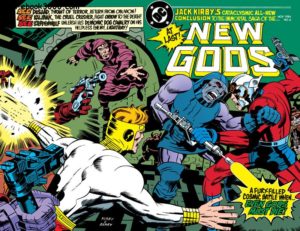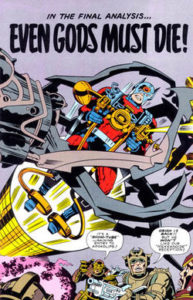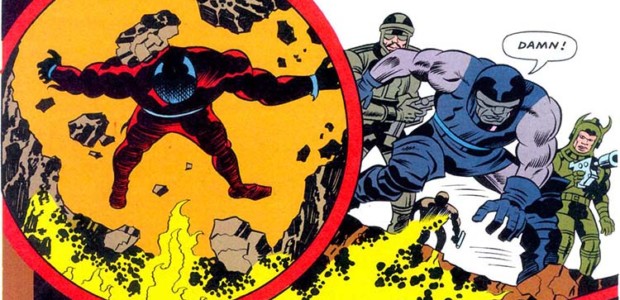I admit it — at first, I was planning on reviewing The Hunger Dogs as part of this “Kirby Month” series I’ve got going, but about halfway through writing that appraisal, it occurred to me that there were any number of fine essays devoted to that graphic novel available online already, and since one of my goals with this entire enterprise has been to shine a light on some of the lesser-discussed works in The King’s canon, I quickly decided to shift my attention elsewhere — although I’m not going that far away.

By way of explanation, in 1984, DC’s post-Carmine Infantino regime of Jenette Kahn and Paul Levitz brought Jack Kirby back into the fold in a big way, wisely deciding to finally allow him to “finish,” albeit in truncated form and after a lengthy hiatus, his legendary Fourth World epic. Right off the bat it was clear that whatever conclusion Kirby would be providing now would be both a) substantially different to what he had originally envisioned given that there were probably a couple hundred comics (at least) along the way to wrapping up the story that he never got the chance to do given the premature cancellation of the entire line a decade previously; and b) not really a “conclusion” at all since all the characters had firmly and irrevocably been “folded” into DC’s larger corporate “universe” by that point. The big finale was going to come in the form of the previously-mentioned The Hunger Dogs, but prior to that, the entire 11-issue run of the original New Gods title was slated to be re-issued in a series of six deluxe-for-the-time monthly comics (featuring no ads, shiny white paper, and a then-high cover price of $2.50) as a lead-in to what was no doubt the comics event of the year. There was just one little wrinkle: the two-old-issues-per-one-new-issue publishing schedule meant that Number Six (cover-dated November, 1984) was going to come up short in its page count.
What, then, to do? Well, why not turn the “back half” of that final book over to Kirby himself and let him tell a new story? And tell a new story he most certainly did — a 48-page story, in fact, that had something of a double editorial remit: It had to serve as a bridge between the “old stuff” and The Hunger Dogs, but it also had to serve as a suitable “ending” in and of itself for the readers who had been picking up the preceding issues but maybe couldn’t (since it wasn’t going to be available on newsstands) or wouldn’t (because six bucks was a lot of money back then) get the big, fancy graphic novel when it came out. And so “Even Gods Must Die!” was born.

As most folks know, The Hunger Dogs had a convoluted gestation, originally being commissioned as a single-issue special carrying the title “On The Road To Armagetto” before being “fleshed out” (and mercilessly fucked with) into its final form, but from what I’ve been able to piece together, this late-in-the-game addition to the Fourth World mythos, while admittedly shoehorned into a (highly fluid, fair enough) pre-existing plan, came about at least a little bit more smoothly after it was commissioned, and frankly it does add quite a bit of depth to both what came before it and, crucially, what was to follow — but I’d be lying if I said that, on the margins at least, it didn’t belie a sign or two of being at least a little bit rushed. More on that in a moment.
First, the good: While the story’s a fairly simple affair — Orion gets wind that Darkseid is holding his mother, Tigra, against her will and duly stages a daring one-man-raid on Apokolips, specifically its deadly slum region known as Armagetto, in order to bust her out come hell or high water — but it’s no doubt effective, and its expanded page count, while perhaps not strictly necessary, allows for the re-introduction of many characters (Desaad, Granny Goodness and her Furies, Kalibak, etc.) in a manner that doesn’t come off as cluttered or read like The King was just checking every box on a “to-do” list; we’re treated to all kinds of awe-inspiring and majestic sets (Darkseid’s HQ shaped like his head? Amazing!) and some of the most stunning “Kirby Tech” we’ve ever seen; there is a lengthy and quite poignant scene between Orion and Lightray that’s allowed room to “breathe” as it plays out over the course of a few pages; and Jack is afforded the opportunity to experiment with some innovative page layouts and panel designs (circular panels, insets, and the like) as he takes his time telling his tale. Plus, the double-page spreads are just plain breathtaking, as you can see:

In addition to this lengthy list of attributes, the shocking ending to this tale really hits like a ton of bricks — don’t get me wrong, I’m a big fan of The Hunger Dogs (despite its handed-down-from-on-high flaws) and think it’s absolutely essential reading, but if the whole Fourth World thing had ended here, well — it would’ve worked. It would’ve ended (again, not that it was really ever going to “end” at this point) on an entirely different note, to be sure, but it would have been tonally, logically, and thematically appropriate for all that.
Where, then, does my charge of this feeling “a little bit rushed” come from? Well, I’m not sure when, or under what set of circumstances, veteran Kirby inker D. Bruce Berry was brought into the fold, but there are a number of instances here where he doesn’t seem to exactly be on his “A” game. A number of pages — hell, most — look just fine, if somewhat less than inspired, but a handful of others clearly skimp on the details, cut corners on the backgrounds, and “dial back” a fair amount of Kirby’s masterful interplay of light and shadows. I can’t believe he’d do this intentionally given the fealty he usually showed toward Jack’s pencils (my mild criticisms of some of his OMAC work notwithstanding, he almost always did a solid job), so my best guess is that he may have come on board at the last minute — and hey, it could have been worse: DC editorial could have given the gig to Greg Theakston. In fact, given how frequently he swooped, vulture-like, into Kirby projects that in no way required his “assistance” during this period, I’m rather surprised they didn’t.

All told, then, “Even Gods Must Die!” is a thoroughly satisfying and impressive read that can hold its own with any other installment of the Fourth World saga, and offers an intriguing “what if this had been the conclusion?” possibility for fans to ponder over. It may have been “wedged in,” but you know what? It still fits into the overall tapestry damn near seamlessly regardless.
Tags: Comic Books, Comics, D. Bruce Berry, DC Comics, Jack Kirby, Jenette Kahn, Paul Levitz, The 1980s, The Hunger Dogs



No Comments